User:10112132
Preface
In geological field, maps which were generated from data whom researchers had collected which then would be portrayed onto a basic map -which in general gives information about Earth’s reliefs interpretation- and then described on a flat plane, called geological map. Geological maps give informations about geological conditions on particular area which includes rocks units and its structures. From geological map, we can obtain type of rocks, thickness, lithologies bearings (strike and dips), faults, folds, fractures, or many processes have had occured on earlier time.
History of Geological Map
William Smith (1769), a British engineer known as a pioneer of stratigraphy, createda very useful geology maps and illustrated the distribution of rocks on a topographic map. The idea of making original map of rocks distribution was coined in 1684 by Martin Lister (1639-1712). Lister stated that the distribution of different types of British landscape could be accurately represented on topographic maps.
”The Soil might either be coloured, by variety of Lines, or Etchings; but the great care must be, very exactly to note upon the Map”
Which Lister concluded that the soil types mapping can also maps the distribution of rocks in the subsurface. Yet, the next important stage from Lister is not continued.
Luigi Ferdinando Marsigli (1658-1730) created topographic maps for military use of the visited countries (Italy, France, Germany, the Balkans, and Turkey). Marsigli published a mining district map in Hungary and sketched the distribution of sulfur near his hometown, Bologna (1717). Probably, the first geological map drawn by an anonymous naval cartographer in 1757 where in the Heligoland islands he added boundaries of four different types of rocks.[1] [2]
Types of Geological Map
Geological map is divided into several types:
- Surface Geological Map, is a map that contains geological information below the surface. This map has various scale from 1:50.000 or greater than that.
- Outcrop map , is a map that contains about the discovery of the location of the rock. These map provide information about rock properties and its structure condition. This type of map are generally in large scale.
- Overview Geological Map, is a map that give information about formation which has been revealed, As well as the location of the extrapolation of formation is still covered by a layer of Holocene. This map is usually have scale from 1:100.000 or smaller than that.
- Structure Map, is a map which the appearance of the depth lines to explain certain layer under the surface.This kind of map has a medium to large scale.
- Schematic geological map, is a map that contains geological data based on topography map.
- Thematic geological map, is a map that contains geological information about natural resources and potential energy in certain location.
- Topography map, is maps showing the height of a region in the form of contour height measured against the average sea level.
- Isopach Map, is a map which represent lines that connect a formation or a layer with the same thickness without sctructural needed. This map generally has a medium to large scale.
- Photogeological Map, is a map creates based on the result of aerial photographs that adapted to the actual condition on field.
- Hydrogeological Map, is a map showing the condition of ground water in certain location and it is known whether the formation is permeable or impermeable.[3]
How To Make Geological Map
The main equipment needed to do geological mapping is:
- Base Map: is used to show an overview of the area that will be mapped.
- Compass and Clinometer: is used to measure the strike and dip from a rocks and geological structure.
- Stationery and field notebook: is used to record and describe the characteristic of rocks was found at the observation location.
- Hammers and Chisels: is used to take rocks samples.
- Hand lens: is used to observe the characteristics of rock that cannot be seen with the eye directly, such as the grain size and others
- Gauge: is used is used to determine the length of an outcrop or structure.
- GPS: is used to determine the outcrop location.
The steps to do geological mapping activity is:
- We make outcrop observation, and make a description of it.
- We measure the position of rocks (strike and dip), geological structure elements, and other geological elements.
- We make a record observations in a field notebook
- We Determine the outcrop location by using GPS.
Steps to create geological maps:
1. Make Geological Maps Framework Geological maps framework is a set of data that is used to the process of makinga map. The contents is:, symbols of station number (track); types of rock symbol; Plotting symbol of strike/dip; Plotting symbol of structure element.
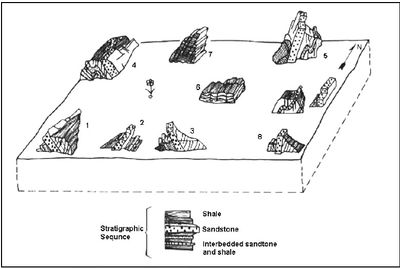
2. Make a Strike and Dip Map This map shows the plots of strike and dipfrom a region. In the reconstruction, it necessary some step:
- Inventory a required data, such as strike and dip, and the description ofrockintorock unitsalong withits contacts as well asan indication ofthe geologicalstructures(faults, folding)
- Plotting data on the map. we make a contour map based on the similarity towards the strike and dip of outcrops were obtained.
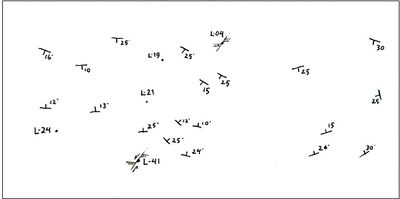
- How to reconstruct the pattern of strike of the rock layering pattern is as follows: plot the data needed; create key strike/dip contour; reconstructs the geological structure if any; and reconstructs the pattern of strike and dip.
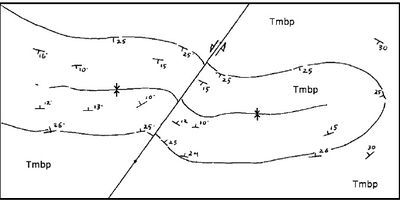
3. Make Geological Map
Some things that need to be considered in making geological maps is: determining the spread of the unit and formation. restrict the lithology in accordance with the lithology contacts on the strike and dip map. Also draw the location of geological structures in accordance with the boundary of the strike and dip map. Give lithology colour in accordance with the standards colour and provide explanation too. And the last, make the cross section from its map
Cross Section
Geological maps can not be considered complete until there is at least one cross section has been created to show the geology below the surface. Cross section describes the structure of a region that is much clearer than a planimetris map.cross section can be drawn in addition to a map of the fair copy,and simplified again as an illustration in a cross section of the report.it can show geological formation boundary at depth,and can also be used to display a fault, cleavage and surface folds on the map.
Measures to make a Cross section:
- Draw the line section (A-B) on face of the map.
- Fasten the map to the drawing board or table with the line Section in parallel on the lower edges of the drawing board or table,
- Tape part map, a few centimeters below the line section, then the line of paper to do the plot lines of the section.
- Basic line drawings on paper are parallel to the lines of the section of the map. Then pull a series of parallel lines on a contour intervals selected Above. The distance of these lines should be aligned with the vertical scale contour maps.
- Press the plastic ruler or a straight steel edge on paper until it cannot move, so that the paper remains parallel to the base line.
- By shifting the point of elevation along the edges, and drop a perpendicular down to the appropriate height on the paper section of every point where this part is cutting the contour lines on a map. Follow these points to give a profile of topography.
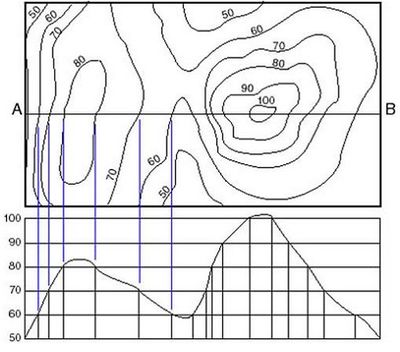
How To Read Geological Maps
Three main elements are commonly found in a geological map is Map Units, Contacts and faults, Strike and Dip. Map Units show different from rock type and other earth materials,showing with the specific color and symbol.
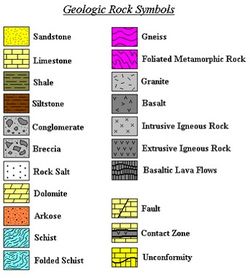
Contacts between two maps showing where the different units of the types of rocks bordering the other rock types.If the border is cear, it will be showing with a thick line,but If the border is uncertain, only showing by the dotted line.
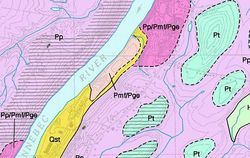
Faults is the location where there is a transfer plate, on a geological maps, the fault line indicates where an experienced unit slid, pushed up or dropped down relative to the binder adjacent units.
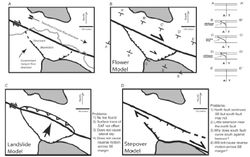
Strike and Dip symbols show the orientation of rocks to the field of fracture. Long lines show the strike, and the short line is dip. Dip is usually also accompanied by a number and direction, which shows how much the angle of outcrop of rock.

Reference
- ↑ Franceschelli, C. &Marabini, S. 2006: Luigi Ferdinando Marsili (1658-1730): A Pioneer In Geomorphological And Archaeological Surveying. In Vai, G.B. Ed, The Origins Of Geology In Italy: Geological Society Of America Special Paper 411: 129-139
- ↑ Oldroyd, D. (2013): Maps As Pictures Or Diagrams: The Early Development Of Geological Maps. In Baker, V.R. Ed, Rethinking The Fabric Of Geology: Geological Society Of America Special Paper 502: 41-101
- ↑ Noor, Djauhari. 2009. Pengantar Geologi Dasar. Bogor: Universitas Pakuan.
- ↑ Zakaria, Zulfiadi. 2011. Manajemen Pemetaan Geologi: Bandung: Universitas Padjadjaran
- ↑ Zakaria, Zulfiadi. 2011. Manajemen Pemetaan Geologi: Bandung: Universitas Padjadjaran
- ↑ Zakaria, Zulfiadi. 2011. Manajemen Pemetaan Geologi: Bandung: Universitas Padjadjaran
- ↑ http://serc.carleton.edu/mathyouneed/slope/topoprofile.html
- ↑ http://www.bssaonline.org/content/92/7/2704/F14.large.jpg
- ↑ http://college.cengage.com/geology/resources/protected/physicallab/thelab/geologicmaps/activities/activity1/activity1.htm
- ↑ http://www.maine.gov/dacf/mgs/pubs/mapuse/surficial/surf-read.htm
- ↑ http://www.state.nj.us/dep/seeds/rocksym.htm